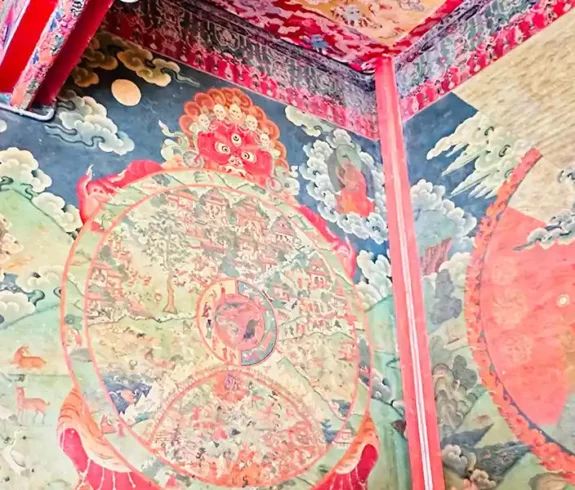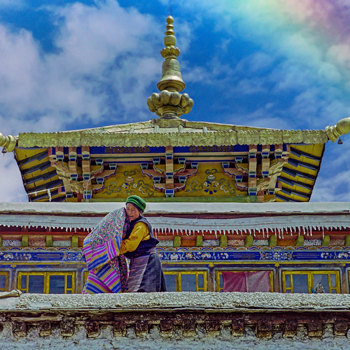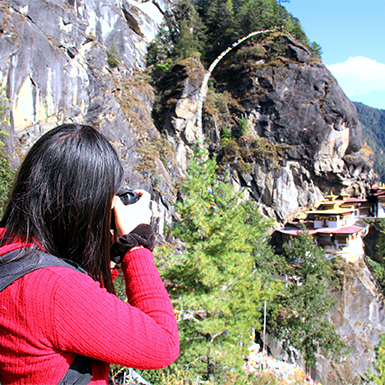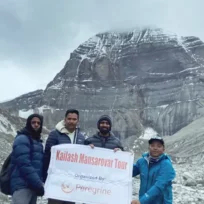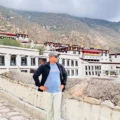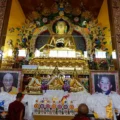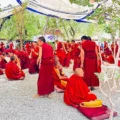Steeped in history and vibrant culture, the Sera Monastery stands proudly on the outskirts of Lhasa, Tibet. Established in 1419 by Jamchen Chojey Sakya Yeshe, a disciple of the revered Tsongkhapa, this grand monastery has become a cornerstone of Gelugpa, a prominent school of Tibetan Buddhism.
Delving more resounding, let’s explore the rich tapestry of the Sera Mey Monastery, encompassing its historical significance, the captivating Sera Mey Monastery Debates, and the opportunity to witness Tibetan Buddhist practices firsthand through tours.
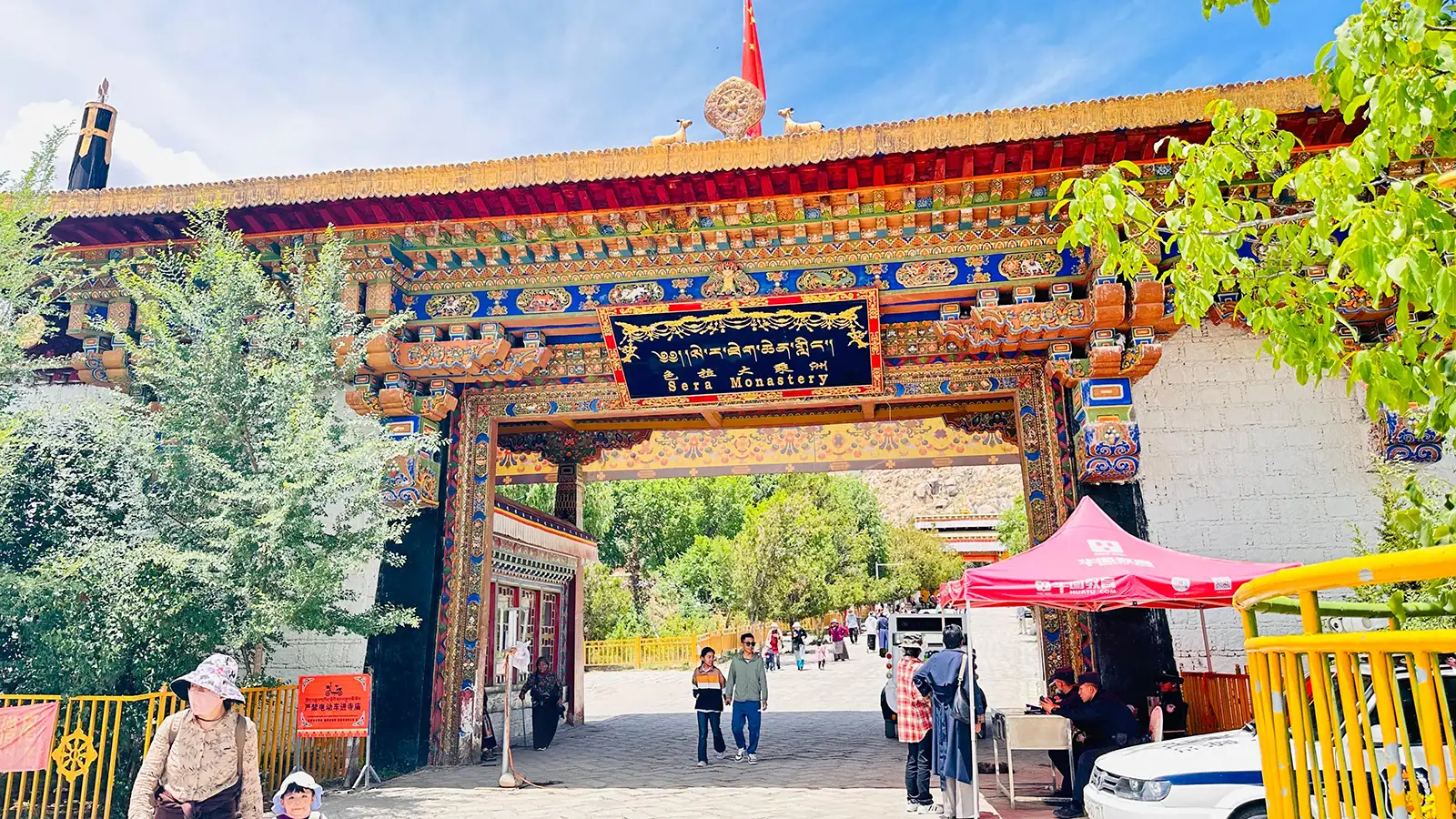
Unveiling Sera Monastery’s History
Founded in the early 15th century, the Sera Monastery boasts a rich past. Its name, “Sera,” translates to “Wild Rose Monastery” in Tibetan, a nod to the abundance of these flowers gracing the hills behind the monastery during its construction. Jamchen Chojey Sakya Yeshe, a dedicated follower of Tsongkhapa, envisioned Sera as a center for Gelugpa learning and established it as one of the “Great Three” Gelug university monasteries alongside Ganden and Drepung monasteries.
Over the centuries, Sera Mey Monastery flourished as a prominent seat of Buddhist scholarship. Monks dedicated themselves to rigorous studies, mastering Buddhist philosophy through debate and dialectic methods. These debates, still a captivating tradition today, are a significant draw for visitors.
Witnessing the Sera Monastery Debates
A unique experience awaits visitors to Sera Monastery – the enthralling Sera Monastery Debates. These debates in the monastery’s lively debate courtyard are not contests to determine winners and losers. Instead, they serve as a dynamic method for monks to hone their understanding of Buddhist philosophy.
Clad in maroon robes, the monks gather in the courtyard, their voices rising in a rhythmic chant as they engage in lively debate using hand gestures and emphatic pronouncements. Witnessing this age-old tradition offers a glimpse into the intellectual heart of Gelugpa practice and the importance of critical thinking within Tibetan Buddhism.
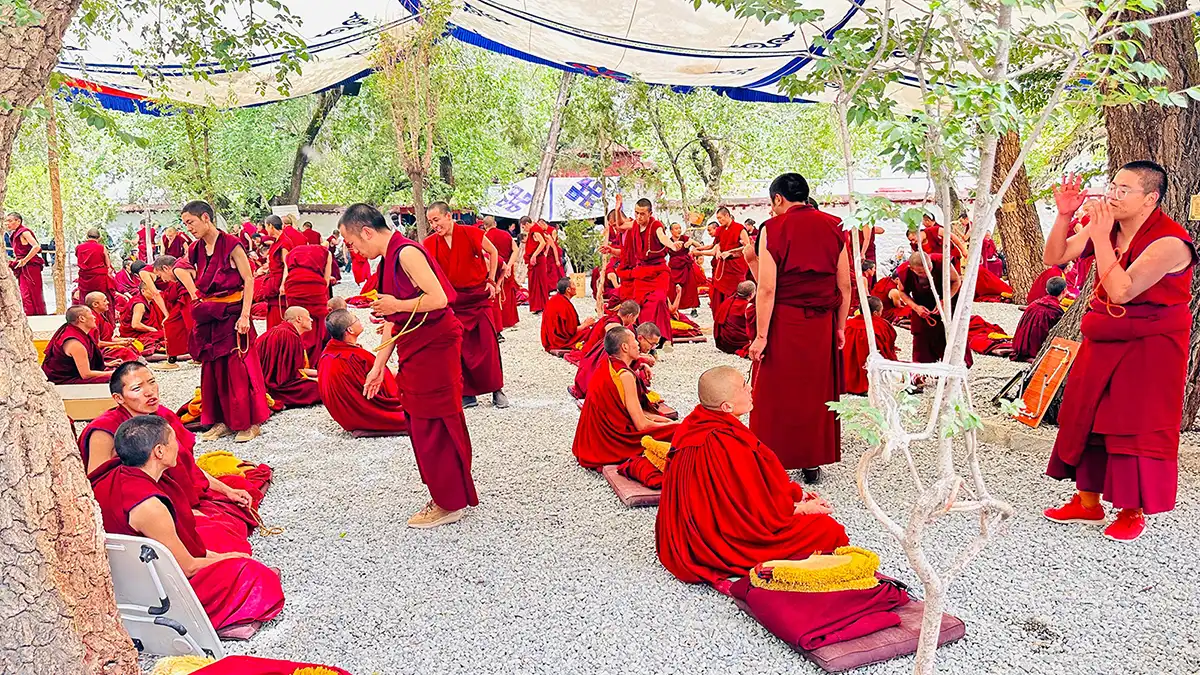
Tibet. This centuries-old tradition is a cornerstone of Tibetan Buddhist education, fostering critical thinking and a deep understanding of Buddhist philosophy.
Exploring Tibetan Buddhist Practices at Sera Monastery
Sera Mey Monastery is not just a historical landmark; it’s a living center of Tibetan Buddhist practice. Visitors on a Sera Monastery Tour can experience this vibrant tradition firsthand. Tours typically include visits to the monastery’s grand halls, adorned with intricate statues and colorful murals depicting Buddhist deities and stories. You might also be able to observe monks engaged in prayer ceremonies or peaceful meditation.
Historical Background: A Legacy of Scholarship and Resilience
The Sera Monastery’s story stretches back centuries, offering a fascinating glimpse into the evolution of Tibetan Buddhism.
Founding and Early Growth: Established in 1419 by Jamchen Chojey Sakya Yeshe, a disciple of the revered Tsongkhapa, Sera Mey Monastery quickly rose to prominence. Its name, “Wild Rose Monastery,” reflects the landscape surrounding the monastery during its construction. Sera, alongside Ganden and Drepung monasteries, became one of the “Great Three” Gelugpa University monasteries renowned for its rigorous academic pursuits.
A Center of Learning: The Gelugpa school of Tibetan Buddhism emphasizes monastic scholarship and intellectual inquiry. Sera Monastery flourished as a center of Buddhist philosophical studies. Monks dedicated themselves to mastering complex doctrines through debate and dialectic methods. These debates, a cornerstone of Gelugpa education, are a captivating tradition today.
Challenges and Restoration: Sera Mey Monastery hasn’t been without its hardships. The monastery suffered severe damage during the tumultuous Cultural Revolution (1966-1976). Damage or destruction affected many buildings, and the monastic community faced severe disruption.
Architectural Features: A Blend of Grandeur and Harmony
Stepping into the Sera Mey Monastery is like entering a world steeped in history and artistic splendor. The monastery’s architectural layout reflects its function as a center of learning and its role as a sacred space.
A Central Hub
The Tsokchen Assembly Hall: The awe-inspiring Tsokchen Assembly Hall dominates the complex. This four-story structure serves as the central hall for congregation and religious ceremonies. Inside, visitors can marvel at:
- 125 Pillars: These pillars provide structural support and symbolize the strength of the Gelugpa tradition.
- Skylight: The skylight illuminating the stunning room makes it feel spacious and serene.
- Murals: The walls are adorned with colorful murals depicting Buddhist deities, historical figures, and scenes from Buddhist scriptures. These murals offer valuable insights into Tibetan Buddhist cosmology and artistic traditions.
- Statues: Enhancing the spiritual atmosphere are statues of revered figures, including Jamchen Chojey, the founder of Sera, and the imposing figure of the Maitreya Buddha.
A Haven for Learning: The Colleges
The three leading colleges—Sera Me, Sera Je, and Ngakpa College—encompass the western part of the complex. These colleges once housed hundreds of monks and functioned as monastic universities. While the number of monks has decreased, the colleges remain vital learning centers.
- Each college has its distinct architectural style, showcasing traditional Tibetan building techniques.
- Look for courtyards, prayer halls, and residences for monks within the college complexes.
A Blend of Practicality and Beauty
Beyond the grand halls and colleges, the Sera Mey Monastery complex comprises numerous other structures.
- Residences for monks provide a sense of community and living space.
- Chapels scattered throughout the complex offer dedicated spaces for prayer and meditation.
Artistic Treasures: Thangkas and Murals
Throughout the Sera Monastery, visitors encounter a wealth of artistic treasures. Elaborate thangkas, Tibetan-painted scrolls depicting Buddhist deities and mandalas, adorn the walls. These thangkas showcase the vibrant colors and intricate details of Tibetan Buddhist art. The murals within the Tsokchen Assembly Hall also offer a captivating glimpse into Buddhist narratives and iconography.
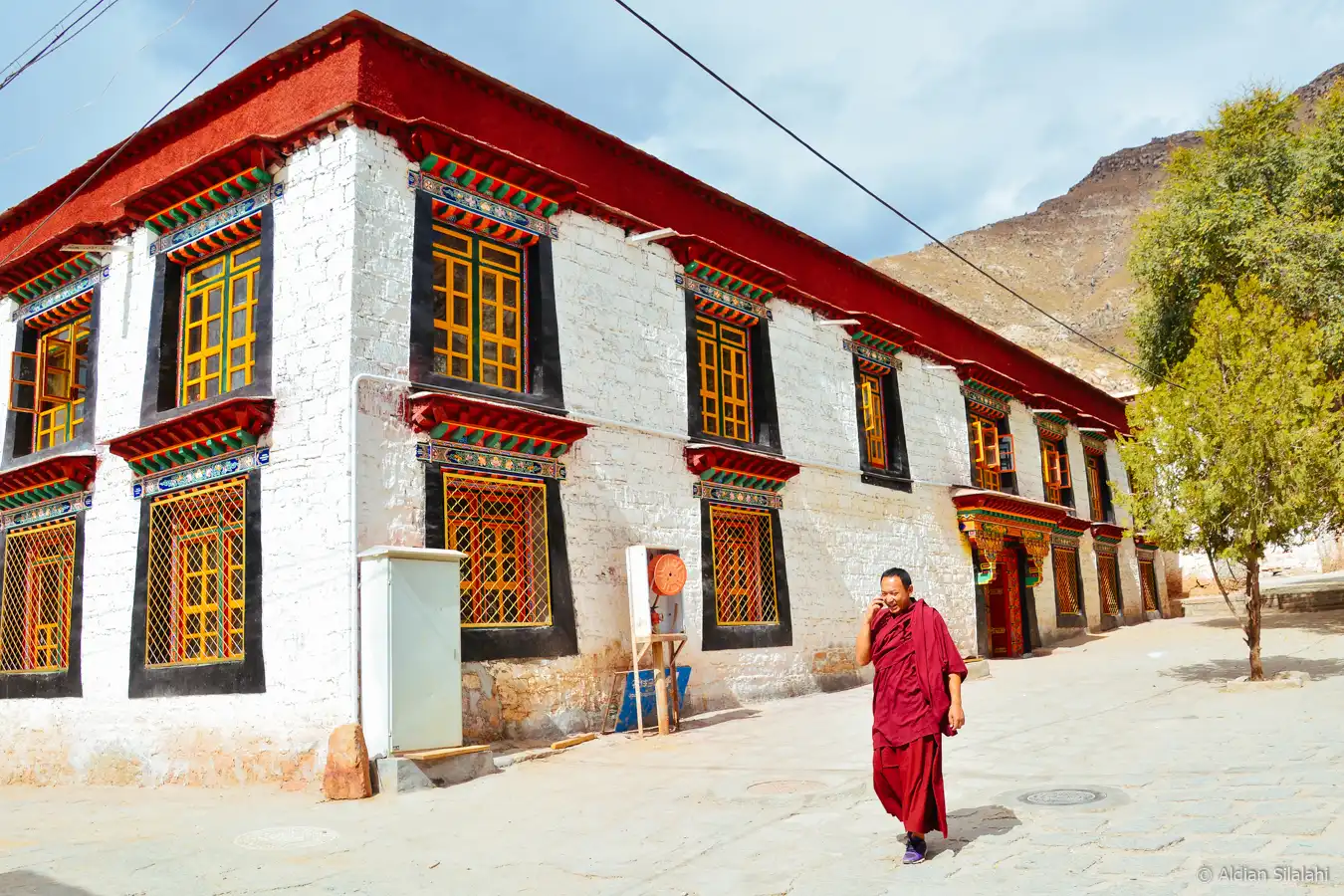
Monastic Life and Educational Practices: Nurturing Wisdom and Discipline
The Sera Mey Monastery isn’t just a stunning architectural marvel; it’s a living center of monastic life and education. Here, we delve into the monks’ unique educational system and daily routines.
A Tradition of Learning
The Sera Monastery has long been a renowned center for Buddhist philosophical studies. The Gelugpa school emphasizes rigorous academic inquiry, and the monks dedicate themselves to mastering complex Buddhist doctrines.
The Core Curriculum
The curriculum at Sera focuses on the Gelugpa tradition’s core teachings, encompassing:
- Buddhist Philosophy: Monks delve into foundational Buddhist texts, grappling with concepts like emptiness, karma, and rebirth.
- Scriptures: In-depth study of the vast canon of Buddhist scriptures equips monks with a deep understanding of the Buddha’s teachings.
- Debate: A cornerstone of Gelugpa education, debate serves as a dynamic method for monks to refine their understanding and critically analyze Buddhist concepts. Witnessing these debates offers a captivating window into the intellectual heart of Tibetan Buddhism (covered in more detail in a later section).
Daily Life and Rituals
Monks at Sera structure their lives around spiritual practice and academic pursuits. A typical day might involve:
- Early Morning Prayers: The monks rise before dawn to participate in chanting and meditation sessions.
- Studies and Debate: Monks dedicate much of the day to studying scriptures, attending lectures, and engaging in lively debate sessions.
- Communal Meals: Monks gather for vegetarian meals taken in silence.
- Evening Prayers and Meditation: The day concludes with further prayers and meditation sessions, fostering inner peace and reflection.
The Debates at Sera Mey Monastery: Sharpening Minds Through Dialogue
One of the most captivating aspects of the Sera Monastery experience is witnessing the Sera Mey Monastery Debates. These aren’t contests to determine winners or losers but rather a dynamic and engaging method for monks to hone their understanding of Buddhist philosophy.
A Lively Spectacle
Head to the lively debate courtyard on weekdays (excluding Sundays and some holidays), typically around 3:00 pm. You’ll witness monks clad in maroon robes engaged in spirited debate there. Their voices rise and fall in rhythmic rhythms punctuated by gestures and accents. The atmosphere is charged with intellectual energy, offering a glimpse into the heart of Gelugpa learning.
The Art of Debate
The debates follow a specific structure:
- Challenger and Defender: Two monks pair up, with one standing as the challenger and the other seated as the defender.
- Formal Procedure: A strict framework governs the debate, ensuring a fair and respectful exchange of ideas.
- Logical Reasoning: Challengers use logic and scriptural references to question the defender’s interpretation of Buddhist doctrines. The defender, in turn, skillfully defends their position using counter-arguments and supporting scriptures.
Beyond Memorization
These debates serve a crucial purpose in the education of monks. They go beyond rote memorization of scriptures. By actively engaging in discussion, monks:
- Develop Critical Thinking: Formulating arguments and responding to challenges hones critical thinking skills.
- Deepen Understanding: Debates encourage monks to delve deeper into complex Buddhist concepts, fostering a more nuanced understanding.
- Sharpen Communication Skills: The debates provide a platform for monks to develop clear and concise communication skills essential for transmitting Buddhist teachings.
Visiting Sera Monastery: A Guide for the Curious Traveler
Tourists seek the rich cultural heritage and a thorough understanding of Tibetan Buddhism that Ser Mey Monastery offers. Therefore, here is how to plan for this visit:
- Planning Your Trip: The best time to visit the Sera Monastery is typically during the spring (April-May) and autumn (September-October). These shoulder seasons offer pleasant weather and manageable crowds. Remember that Lhasa’s altitude (over 3,600 meters) can be challenging, so proper acclimatization is essential.
- Getting There: Located approximately 5 kilometers north of central Lhasa, the Sera Monastery is easily accessible. You can take a taxi or hop on one of the public buses (routes 6, 16, 20, 23, or 24) that stop near the monastery entrance.
- Opening Hours and Fees: Sera Monastery opens at 9 am and closes at 4 pm daily. You’ll pay a small fee at the gate, but you might also need to part with some extra cash if you want to take photos inside certain chapels (don’t use the flash).
- Respectful Exploration: Remember that Sera Monastery is a functioning monastery. Dress appropriately and avoid aggressive or disruptive behavior. Be mindful of the prayers and ceremonies, and avoid taking pictures during these times.
- Witnessing the Debates: If you’re keen to experience the captivating Sera Mey Monastery Debates, plan your visit for a weekday afternoon (excluding Sundays and some holidays) around 3:00 pm. Find a respectful spot in the debate courtyard to observe the lively exchange.
- A Special Note for International Travelers: Foreigners must obtain a Protected Area Permit (PAP) to visit Tibet, which you must secure through internet registration before arrival. It is advisable to organize your trip with an experienced tour company. They will guide you in obtaining the permit and ensuring your stay is comfortable while respecting cultural norms.
Cultural and Religious Significance: A Beacon of Learning and Tradition
The Sera Monastery transcends its role as a historical landmark. It serves as a cornerstone of Tibetan Buddhist culture and tradition, both locally and globally. Let’s delve deeper into its significance, exploring its impact on the surrounding community, its role as a center of Buddhist scholarship, and its contribution to preserving Tibetan culture.
A-Pillar of the Lhasa Community
The Sera Mey Monastery has been vital to the Lhasa community for centuries. The monks there dedicate themselves to religious practice and contribute to the social fabric. They offer spiritual guidance to residents and participate in traditional festivals, strengthening the region’s cultural identity.
A Center of Buddhist Scholarship
Sera Monastery Tours often highlight its reputation as a premier Gelugpa University monastery. This significance extends far beyond Lhasa. Throughout history, the monastery has produced countless accomplished scholars and teachers who have significantly impacted Tibetan Buddhism. Here are some notable figures:
- The 5th Dalai Lama: This revered spiritual leader spent time studying at Sera Mey Monastery, further solidifying its importance within the Gelugpa tradition. Learning about such historical figures can be a fascinating aspect of Sera Monastery Tours.
- Geshe Kelzang Gyatso: The renowned scholar-monk Geshe Kelzang Gyatso receives credit for revitalizing the study and practice of logic and debate within the Gelugpa school. His influential writings, explored during Sera Mey Monastery Tours that delve into the history of the monastery’s educational practices, continue to shape Buddhist discourse today.
Preserving Tibetan Culture
The Sera Monastery plays a crucial role in safeguarding Tibetan Buddhist heritage. The rigorous curriculum and emphasis on debate, witnessed during Sera Monastery Debates, ensure the preservation and transmission of centuries-old knowledge and traditions. Monks meticulously copy and preserve ancient scriptures, safeguarding this rich cultural heritage.
Preservation and Tourism: Balancing Tradition with Modernity
The Sera Mey Monastery faces the challenge of balancing the preservation needs with the growing interest of tourists. Here’s a closer look at these aspects:
- Safeguarding a Legacy: There is a big push to keep Sera Mey Monastery intact. China has funded various projects to restore the buildings’ structural stability and safeguard murals and artwork. Tibetans involved in both local and international affairs make essential contributions. Endowments and programs facilitate this structure’s maintenance and its customs’ sustenance.
- The Impact of Tourism: The Sera Mey Monastery is a major tourist magnet due to its unique practices and exciting history. Tourism revenue is significant for the monastery’s upkeep and supplies. Controlling visitors’ movements is essential to avoid disrupting current religious activities.
- Respectful Exploration: Sera Mey Monastery Tours can be a valuable way to learn about the monastery’s history and traditions. Responsible tour operators ensure visitors dress modestly, maintain a respectful demeanor, and avoid loud or disruptive behavior during prayers and ceremonies.
- Balancing Needs: The Sera Monastery strives to balance preserving its sacred space and welcoming visitors. Religious functions restrict some areas, while designated areas are open for visitor exploration. Understanding these guidelines fosters a more enriching experience for everyone.
Witnessing the Debates
A captivating aspect of Sera Monastery Tours is witnessing the Sera Monastery Debates. These lively debates occur on weekdays (excluding Sundays and some holidays), typically around 3:00 pm in a designated courtyard. Visitors can observe from a respectful distance, gaining a glimpse into the intellectual heart of Gelugpa practice.
Conclusion
Seramatha stands as a testament to the enduring heritage of Tibetan Buddhism. This historic landmark transcends its architectural beauty, offering a vibrant center of monastic life, scholarship, and spiritual practice. Throughout this exploration, we’ve delved into the rich tapestry of the Sera Monastery’s story:
- A Center of Learning: Established in the 15th century, Sera Mey Monastery has long been a renowned Gelugpa University monastery. Its rigorous curriculum emphasizes Buddhist philosophy, scripture study, and the unique practice of debate, fostering intellectual inquiry and deep understanding.
- A Living Tradition: The daily lives of monks at Sera Monastery revolve around prayer, meditation, and studies. When you see these practices, you can see the heart of Tibetan Buddhist monastic life.
- A Cultural Gem: Sera Monastery is essential in preserving Tibet’s Buddhist heritage. The meticulous preservation of ancient scriptures and captivating debates ensures the continuation of centuries-old traditions.
- A Place of Inspiration: The Sera Monastery’s significance extends beyond Tibet. It is a source of inspiration for spiritual seekers worldwide, offering a window into the rich tapestry of Buddhist philosophy and practice.
Planning Your Visit
If you’re fortunate enough to visit the Sera Mey Monastery, remember these pointers for a respectful and enriching experience:
- Wear appropriate clothing and remain calm during prayers and ceremonies.
- Responsible tour operators can guide you through the monastery’s history and traditions.
- The Sera Mey Monastery Debates offer a captivating glimpse into Gelugpa’s intellectual practices. Observe from a respectful distance.
- Be mindful of photography restrictions in certain areas, and avoid using flash.
